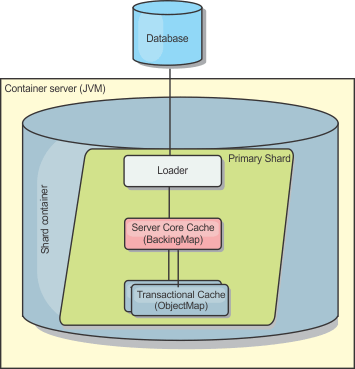Plug-ins for communicating with databases
With a Loader plug-in, an ObjectGrid map can behave as a memory cache for data that is typically kept in a persistent store on either the same system or some other system. Typically, a database or file system is used as the persistent store. A remote Java™ virtual machine (JVM) can also be used as the source of data, allowing hub-based caches to be built using ObjectGrid. A loader has the logic for reading and writing data to and from a persistent store.
Loaders are backing map plug-ins that are invoked when changes are made to the backing map or when the backing map is unable to satisfy a data request (a cache miss).

WebSphere® eXtreme Scale includes two built-in loaders to integrate with relational database back ends. The Java Persistence API (JPA) loaders use the Object-Relational Mapping (ORM) capabilities of both the OpenJPA and Hibernate implementations of the JPA specification.
Using a loader
- A backing map can have only one loader.
- A client backing map (near cache) cannot have a loader.
- A loader definition can be applied to multiple backing maps, but each backing map has its own loader instance.
Loaders in multi-master configurations
For considerations about using loaders in multi-master configurations, see Loader considerations in a multi-master topology.
Programmatically plug in a Loader
The following snippet of code demonstrates how to plug an application-provided Loader into the backing map for map1 using the ObjectGrid API:
import com.ibm.websphere.objectgrid.ObjectGridManagerFactory;
import com.ibm.websphere.objectgrid.ObjectGridManager;
import com.ibm.websphere.objectgrid.ObjectGrid;
import com.ibm.websphere.objectgrid.BackingMap;
ObjectGridManager ogManager = ObjectGridManagerFactory.getObjectGridManager();
ObjectGrid og = ogManager.createObjectGrid( "grid" );
BackingMap bm = og.defineMap( "map1" );
MyLoader loader = new MyLoader();
loader.setDataBaseName("testdb");
loader.setIsolationLevel("read committed");
bm.setLoader( loader );This snippet assumes that the MyLoader class is the application-provided class that implements the com.ibm.websphere.objectgrid.plugins.Loader interface. Because the association of a Loader with a backing map cannot be changed after ObjectGrid is initialized, the code must be run before invoking the initialize method of the ObjectGrid interface that is being called. An IllegalStateException exception occurs on a setLoader method call if it is called after initialization has occurred.
The application-provided Loader can have set properties. In the example, the MyLoader loader is used to read and write data from a table in a relational database. The loader must specify the name of the database and the SQL isolation level. The MyLoader loader has the setDataBaseName and setIsolationLevel methods that allow the application to set these two Loader properties.
XML configuration approach to plug in a Loader
<?xml version="1.0" encoding="UTF-8" ?>
<objectGridConfig xmlns:xsi="http://www.w3.org/2001/XMLSchema-instance"
xsi:schemaLocation="http://ibm.com/ws/objectgrid/config ../objectGrid.xsd"
xmlns="http://ibm.com/ws/objectgrid/config">
<objectGrids>
<objectGrid name="grid">
<backingMap name="map1" pluginCollectionRef="map1" lockStrategy="OPTIMISTIC" />
</objectGrid>
</objectGrids>
<backingMapPluginCollections>
<backingMapPluginCollection id="map1">
<bean id="Loader" className="com.myapplication.MyLoader">
<property name="dataBaseName"
type="java.lang.String"
value="testdb"
description="database name" />
<property name="isolationLevel"
type="java.lang.String"
value="read committed"
description="iso level" />
</bean>
</backingMapPluginCollection>
</backingMapPluginCollections>
</objectGridConfig>